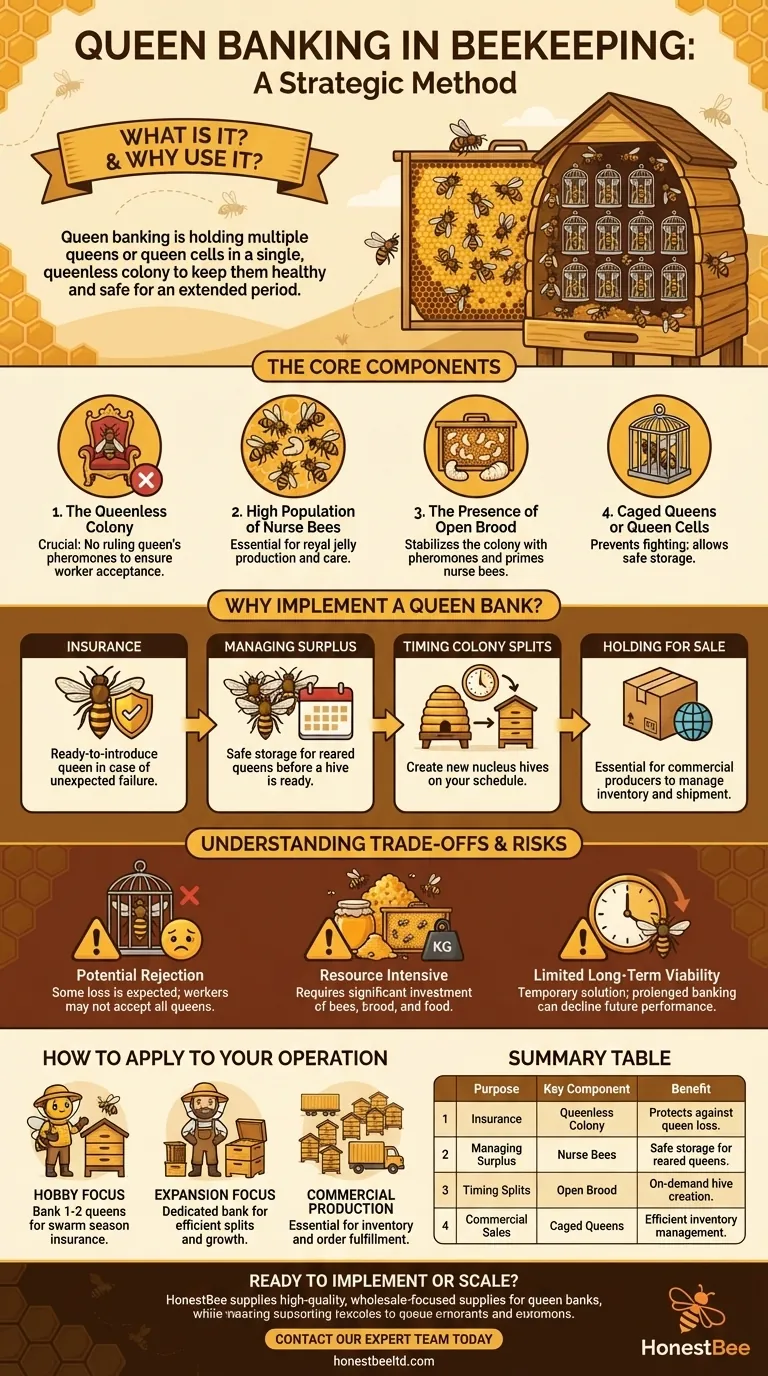In beekeeping, queen banking is a strategic method for holding multiple queens or queen cells in a single, queenless colony. This technique allows beekeepers to keep queens healthy and safe for an extended period, serving as a living repository for surplus queens, those awaiting introduction to a new hive, or as a critical insurance policy against unexpected colony issues.
Queen banking transforms a single hive into a high-density queen reservoir. The fundamental principle is to create a queenless environment rich with nurse bees that will care for many individually caged queens, treating them as their own.

The Core Components of a Queen Bank
A successful queen bank isn't just a random box of bees. It's a carefully managed environment designed to meet the specific needs of the queens it holds.
The Queenless Colony
The absolute requirement for a queen bank is that it must be queenless. The absence of a ruling queen's pheromones is what makes the worker bees receptive to caring for the new queens in their cages.
A High Population of Nurse Bees
The bank must be packed with young nurse bees. These are the bees responsible for producing royal jelly and tending to the needs of royalty, and their presence in large numbers ensures each banked queen receives adequate attention and nutrition.
The Presence of Open Brood
Adding a frame of open brood (eggs and young larvae) from another hive serves a critical purpose. It emits pheromones that stabilize the colony, keeps the nurse bees physiologically primed to care for royalty, and prevents them from developing into laying workers.
Caged Queens or Queen Cells
The queens or mature queen cells are placed into the bank within individual cages. This confinement is crucial, as it prevents the queens from emerging and immediately fighting to the death, which is their natural instinct.
Why Implement a Queen Bank?
Beekeepers use queen banks not just for storage, but as a powerful strategic tool to improve their operations and respond to challenges effectively.
Insurance Against Queen Failure
The most common use is as an insurance policy. If a colony's queen unexpectedly dies or begins to fail, having a ready-to-introduce queen on hand can save the colony from decline.
Managing Surplus from Queen Rearing
For beekeepers who rear their own queens, a bank is essential. It provides a safe holding space for queens that are ready before a hive is, or when more queens are produced than immediately needed.
Timing Colony Splits
A queen bank allows a beekeeper to make colony splits or create new nucleus hives on their own schedule. They can prepare the new hives and introduce a banked queen when the timing is optimal, rather than waiting for a queen cell to mature.
Holding Queens for Sale or Shipment
Commercial queen producers rely heavily on banks to manage their inventory. This allows them to hold queens safely until they are shipped to customers around the country.
Understanding the Trade-offs and Risks
While incredibly useful, queen banking requires careful management and is not without its challenges.
Potential for Queen Rejection
Even in a well-managed bank, the worker bees may not accept and care for every single queen. Some loss is to be expected.
Resource Intensive
A queen bank must be a strong, populous, and well-fed colony. Maintaining this requires a significant investment of resources, including bees, brood, and food from other hives.
Limited Long-Term Viability
Banking is a temporary solution. While it can hold queens for several weeks, queens stored for too long may experience a decline in their future egg-laying performance once they are introduced to a full colony.
How to Apply This to Your Operation
Your decision to use a queen bank should align directly with the scale and goals of your beekeeping.
- If your primary focus is hobby beekeeping: Banking one or two extra queens during swarm season provides a simple and effective insurance policy against sudden queen loss.
- If your primary focus is expanding your apiary: A dedicated queen bank is an excellent tool for efficiently making colony splits and growing your operation.
- If your primary focus is commercial production: Banking is an essential and non-negotiable part of your workflow for managing inventory and fulfilling orders.
Ultimately, a well-managed queen bank gives a beekeeper proactive control over their apiary's most valuable asset.
Summary Table:
| Purpose | Key Component | Benefit |
|---|---|---|
| Insurance | Queenless Colony | Protects against unexpected queen loss |
| Managing Surplus | Nurse Bees | Provides safe storage for reared queens |
| Timing Splits | Open Brood | Allows for on-demand hive creation |
| Commercial Sales | Caged Queens | Enables efficient inventory management |
Ready to implement queen banking or scale your operation?
HONESTBEE supplies commercial apiaries and beekeeping equipment distributors with the high-quality, wholesale-focused supplies needed to build and manage successful queen banks. From durable queen cages to essential hive equipment, we provide the tools for proactive apiary management.
Contact our expert team today to discuss your specific needs and discover how our products can support your beekeeping success.
Visual Guide

Related Products
- No Grafting Queen Rearing Kit: System for Royal Jelly Production and Queen Rearing
- JZBZ Push-In Queen Cell Cups for Beekeeping
- Plastic Chinese Queen Grafting Tool for Bee Queen Rearing
- Brown Nicot Queen Cell Cups for Breeding Queen Bees Beekeeping
- JZBZ Type Wide Base Plastic Queen Cell Cups for Base Mounting and Queen Rearing
People Also Ask
- What are the two main categories of queen rearing methods? Grafting vs. Non-Grafting Explained
- What is the timeline for queen breeding? A 28-Day Guide from Egg to Laying Queen
- What is requeening, and why is it performed? Take Control of Your Hive's Health and Productivity
- What should be done once eggs are present in the comb box? A Guide to Maximizing Queen Rearing Success
- What are the developmental periods for different bee castes? Master the 16, 21, and 24-Day Timelines for Hive Success




